
USB flash drives have come a long way since their inception in the early 2000s. These small and portable devices have revolutionized data storage, offering convenience and versatility to users worldwide. In this article, we will explore the evolution of USB flash drives and their significant impact on data storage.
From Floppy Disks to Thumb-sized Marvels USB flash drives, also known as thumb drives or pen drives, emerged as a replacement for traditional floppy disks and CDs. With limited storage capacities ranging from a few megabytes to a few gigabytes, early USB flash drives provided a convenient way to carry files and data on-the-go. Their plug-and-play functionality and fast data transfer rates quickly made them a preferred choice over bulky and slow-to-read floppy disks.

A Giant Leap in Data Storage As technology advanced, so did the capabilities of USB flash drives. Manufacturers started increasing storage capacities, allowing users to carry larger files, documents, photos, and even videos. From a few gigabytes, USB drives expanded to hold tens, then hundreds of gigabytes of data. Today, it's common to find USB flash drives with terabytes of storage space, a far cry from their humble beginnings.
With the demand for faster data transfer rates, USB flash drives evolved to support the latest USB standards. USB 2.0, which dominated the market in the early 2000s, gave way to USB 3.0, offering significantly faster transfer speeds. Subsequently, USB 3.1 and USB 3.2 emerged, further enhancing performance and efficiency. These speed improvements have made USB flash drives ideal for transferring large files and running applications directly from the drive.
With the increasing importance of data security, USB flash drives now come with advanced encryption and password protection features. These security measures safeguard sensitive information, preventing unauthorized access to your files. Biometric authentication, such as fingerprint scanning, is also becoming more prevalent, adding an extra layer of protection against data breaches.

USB flash drives have evolved not only in terms of functionality but also in design. Manufacturers now offer a wide array of compact and stylish designs to cater to different user preferences. From sleek metal casings to quirky shapes and colors, USB flash drives have become a fashion statement while remaining a powerful data storage tool.
The evolution of USB flash drives has transformed data storage, providing users with a convenient, portable, and secure means to carry their valuable data. From their humble beginnings as floppy disk replacements to sleek, high-capacity, and feature-rich devices, USB flash drives continue to impact the way we store and transfer data. As technology progresses, we can expect even more exciting advancements in the realm of USB flash drives, further shaping the future of data storage and accessibility.